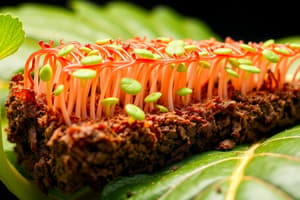Podcast
Questions and Answers
What is the primary function of chloroplasts in plant cells?
What is the primary function of chloroplasts in plant cells?
Which plant group does not possess vascular tissue?
Which plant group does not possess vascular tissue?
What role do roots play in a plant's survival?
What role do roots play in a plant's survival?
Which of the following best describes phototropism?
Which of the following best describes phototropism?
Signup and view all the answers
What distinguishes gymnosperms from angiosperms?
What distinguishes gymnosperms from angiosperms?
Signup and view all the answers
What process do plants use to release energy stored in sugars?
What process do plants use to release energy stored in sugars?
Signup and view all the answers
How do flowers contribute to plant reproduction?
How do flowers contribute to plant reproduction?
Signup and view all the answers
Which factor does NOT influence plant growth?
Which factor does NOT influence plant growth?
Signup and view all the answers
Study Notes
Introduction to Botany
- Botany is the scientific study of plants.
- It encompasses a vast range of topics, from the structure and function of individual cells to the interactions between plants and their environment.
- This includes plant diversity, evolution, classification, physiology, ecology, and economic importance.
Plant Structure and Function
- Plants, like all organisms, are composed of cells.
- Plant cells are unique in their possession of cell walls made primarily of cellulose.
- Plant cells often contain chloroplasts, the site of photosynthesis.
- Plants exhibit a wide range of structures, including roots, stems, leaves, flowers, and fruits.
- Roots absorb water and nutrients from the soil.
- Stems support the plant and transport water and nutrients.
- Leaves are the primary sites of photosynthesis.
- Flowers are the reproductive structures of angiosperms.
- Fruits develop from the flower's ovary and protect seeds.
- Different plant parts have distinct functions, contributing to the overall survival and reproduction of the plant.
Plant Physiology
- Photosynthesis is the process by which plants convert light energy into chemical energy in the form of sugars.
- Respiration is the process by which plants release energy stored in sugars.
- Plant growth is influenced by external factors such as light, temperature, water, and nutrients.
- Hormones regulate various aspects of plant growth and development, such as flowering, fruit development, and response to stress.
- Plants exhibit various tropisms (e.g., phototropism, gravitropism, thigmotropism) in response to external stimuli.
Plant Diversity and Classification
- Plants are classified into different groups based on their evolutionary relationships.
- The major plant groups include:
- Bryophytes (mosses, liverworts, hornworts): non-vascular plants
- Pteridophytes (ferns, horsetails, club mosses): vascular plants lacking seeds
- Gymnosperms (conifers, cycads, ginkgoes): vascular plants with seeds but no flowers
- Angiosperms (flowering plants): vascular plants with seeds and flowers.
- Each group has unique characteristics that differentiate it from others.
Plant Ecology
- Plants interact with their environment in various ways, influencing and being influenced by other organisms.
- Plants form the base of most terrestrial food webs.
- They are essential for maintaining the balance of ecosystems.
- Plants contribute significantly to soil formation and stability.
- Competition for resources (water, sunlight, nutrients) among plants is a common ecological phenomenon.
- Plants are crucial in regulating atmospheric carbon dioxide levels.
- Interactions with other organisms, such as pollination and seed dispersal, are vital for plant reproduction and survival.
Economic Importance of Plants
- Plants are vital for human survival and economic well-being.
- They are sources of food, timber, fiber, medicine, and fuel.
- Agriculture relies heavily on plants for food production.
- Many industrial products are derived from plants.
- Plants contribute to the beauty and biodiversity of the Earth.
- Understanding plant biology is critical for sustainable agriculture and environmental conservation.
Studying That Suits You
Use AI to generate personalized quizzes and flashcards to suit your learning preferences.
Description
This quiz explores the fascinating field of botany, focusing on plant structure and function. It covers topics such as plant cells, the roles of various plant parts, and the processes of photosynthesis and reproduction. Test your knowledge about the intricate systems that sustain plant life and their significance in the ecosystem.




